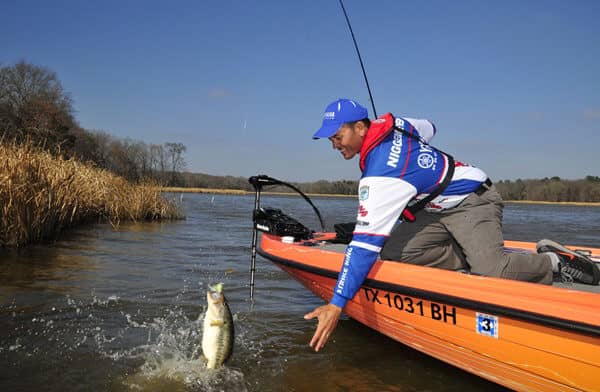How To Catch Spawning Fish
Yamaha 07.12.11

Sight-fishing for spring largemouths can be one of the most difficult ways to catch them, even though the fish are usually in very shallow water and clearly visible to anglers. That’s why fishermen like Yamaha pro James Niggemeyer have developed alternative techniques and that often do tempt these stubborn bass.
“It takes years of experience to learn how to ‘read’ a bass you can see and determine if it is even going to bite,” explains Niggemeyer, a Bassmaster® Elite contender who perfected his shallow fishing strategies on Lake Fork, “so instead of spending a lot of time trying to coax one fish I can see, I look for dingy, off-colored water that holds bass I can’t see.
“That sounds a little strange, perhaps, but it allows me to fish in a totally different style with different lures. Remember, most of the time we don’t see the bass we’re casting to the rest of the year, so I’m not doing anything unusual, and although the bass may be on beds and spawning, they’re not nearly as spooky in dirty water as they are in clear water.”
Niggemeyer normally uses three different lures under these conditions, a spinnerbait, a swim jig, and a soft plastic stick worm. He concentrates in water depths of three feet or less, and the common denominator in using all three lures is fishing them very slowly.
 “I like to use the spinnerbait on days that are windy or rainy when the surface has a ripple so bass react more to noise and vibration,” explains the Yamaha pro. “I slow roll it just above the bottom and parallel to the shoreline, barely pumping my rod tip to create different vibrations. I usually use a 3/8 or ½-ounce model with a chartreuse/white skirt, and with Colorado and willow leaf blades. That gives me a fairly small profile lure but with both flash and vibration.”
“I like to use the spinnerbait on days that are windy or rainy when the surface has a ripple so bass react more to noise and vibration,” explains the Yamaha pro. “I slow roll it just above the bottom and parallel to the shoreline, barely pumping my rod tip to create different vibrations. I usually use a 3/8 or ½-ounce model with a chartreuse/white skirt, and with Colorado and willow leaf blades. That gives me a fairly small profile lure but with both flash and vibration.”
When days are calm and brighter, Niggemeyer changes to a swim jig, a lure that features a small blade just in front of the jig head that causes the lure to wobble. Again, he emphasizes, the key to success is using a very slow retrieve.
“I cast as shallow as I can get the lure, then reel back steadily so the jig is just barely wobbling,” he continues. “It vibrates totally differently than a spinnerbait, and I like to fish it close to anything that creates an edge, be it a grassline, a log, some rocks, even a boat ramp.
“Bass seem to feel an edge provides some security since nothing can come from that side to rob their nests and they don’t have to watch it as closely. That means the fish will see my swim jig coming in front of that edge and hopefully they’ll be more likely to strike it.”
The Yamaha angler prefers a small ¼ or 3/8-ounce swim jig that he rigs with 25 to 30 pound braided line, primarily to have strength to control a larger bass and move it away from cover quickly.
Niggemeyer’s third option for shallow bass he can’t see is a plastic stick worm, usually rigged weightless and fished on 16 to 20 pound fluorocarbon line. If he’s fishing fairly open water, the Yamaha pro may rig the lure wacky-style, in which the hook is inserted through the middle of the bait, but if he’s working in and around cover, he uses a traditional Texas-style rigging that keeps the lure weedless.
“These worms shimmy and vibrate as they fall,” notes Niggemeyer, “so I when I use them, I let them fall to the bottom, then just let them sit there motionless. After perhaps five to 10 seconds, I raise my rod tip and then drop it so the lure falls and shimmies down again.
“I can easily envision a bass watching my bait fall and sitting on the bottom, as if trying to decide whether or not it should strike,” he laughs. “When I raise my rod and the worm starts vibrating on its way back down, the bass just can’t resist it.”

